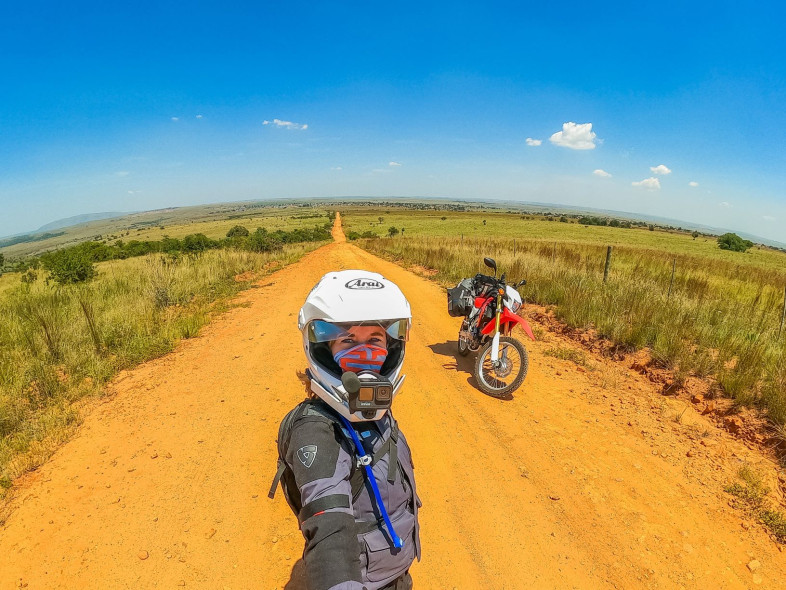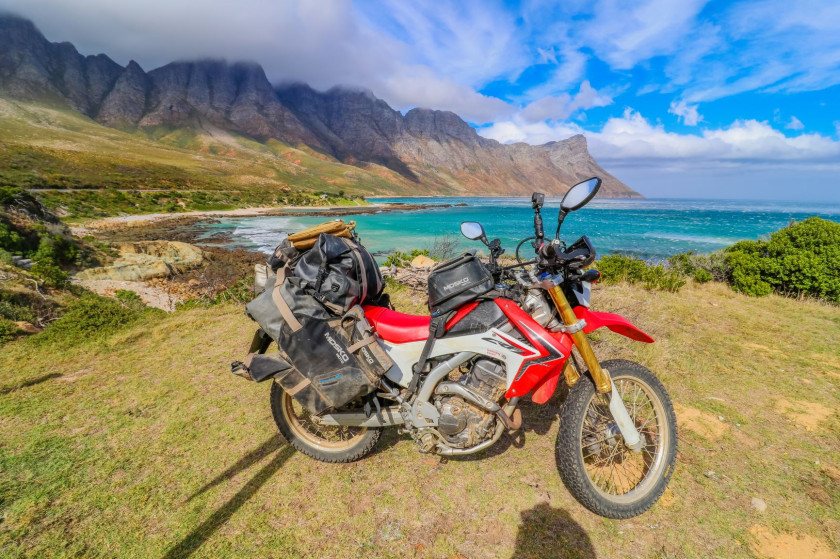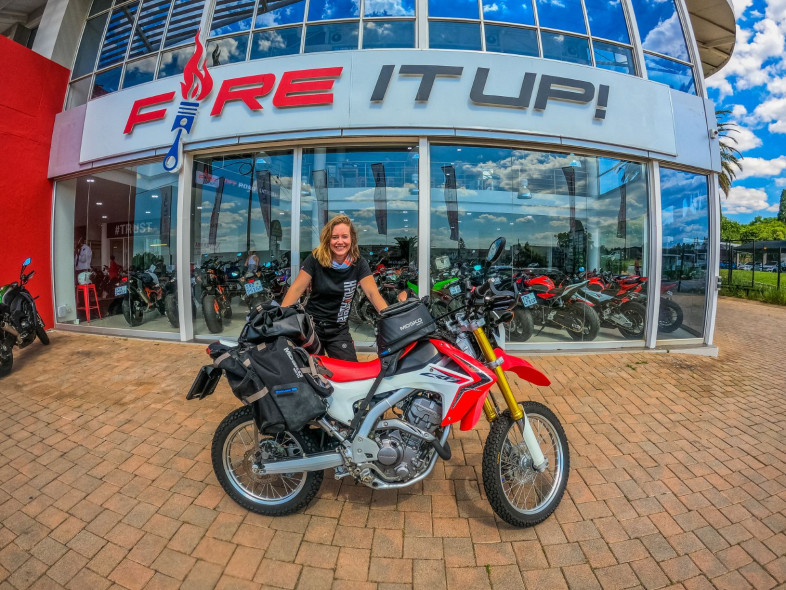
So many of you have asked me to create a review video of Savannah. Now that I have reached the 10.000km milestone, it is time to evaluate how she has been doing. But instead of a video, I decided to write a blog, and here it is!
Why a Honda CRF250L?
Let’s first talk about my choice for the Honda CRF250L as the bike to explore Africa with. Upon my arrival in South Africa, I was extremely eager to hit the road and start filming after being in lockdown for so many months. This meant that I gave myself very little time to search for a motorcycle. I just went to the biggest second hand motorcycle dealer in Johannesburg and looked for the cheapest bike they had. It was Savannah.
Besides being the cheapest bike, the CRF250L had a few other characteristics that made me decide this bike was going to be my partner for Southern Africa. I knew the bike had a good reputation in terms of reliability, it’s a Honda after all. Spare parts and maintenance work would be relatively cheap and the bike was designed for off-roading. Something I was planning to do a lot on this trip!
With only 145 kilograms, it is such a light bike that it is easy to handle and to pick-up in case of a fall. A bike like this one would give me the confidence to choose for more difficult mountain routes and technical terrain. And I have to say, after 10.000 kilometers, Savannah was definitely the right choice!
What did I put the bike through?
When I bought Savannah, she was already 8 years old and had 23.500 kilometers on the odometer. Within a few months, I added another 10,000 kilometers to that, riding with her on tarmac, dirt roads, muddy roads, and lots and lots of sandy roads. The majority of the mileage was on unpaved terrain, of which some could perhaps even be qualified as hard enduro. I am thinking of Sani pass in South Africa for instance, or a remote part of the Fish River canyon in Namibia.
Being quite lucky with the weather, I had virtually no riding in the rain, but I did experience gale force winds coming from virtually any direction. The small weight of the bike was a slight disadvantage in the latter conditions. When the wind was strong,Savannah and I were unintentionally dancing all over the road.

Aftermarket upgrades
Because I wanted to leave Johannesburg as quickly as possible, so I could start exploring and filming again, I hardly did any aftermarket upgrades to Savannah. Under normal circumstances, I love to add aftermarket parts to my motorcycles to make them better and more personalised. But, in South Africa aftermarket accessories are not readily available like in Europe for example. And importing them takes months, I now know.
The only accessory that I initially got in Johannesburg were some hand guards to protect my levers. When I reached Cape Town after about 5000 kilometers of riding, I had some crash guards installed too. I would have loved to get a better bash plate too if it had been available in South Africa, but that wasn’t the case unfortunately.
Exhaust
I love a good sound on a motorcycle. That’s the reason that my first bike, a Ducati Monster 796 had an aftermarket, double Acrapovic exhaust system. My first Royal Enfield Himalayan got a loud aftermarket pipe that I found in India, and my Honda CB500x Ronin was also given an Acrapovic for her birthday. The stock exhaust of the CRF250L is just as disappointing as the stock exhaust of many motorcycles. This time, I didn’t have the time to replace it for something with a bit more grunt. In the past few months, I’ve been making my way through Southern Africa on a lawn mower in that regard!
Fuel tank challenge
The most important aftermarket part for the Honda CRF250L is a larger fuel tank, especially when you want to use the bike for touring. The stock tank only holds a disappointing 7.7 liters and I would have loved to upgrade it to a 12.5 liters tank. I ordered one on a South African webshop but they were still waiting for it to come from Europe. Four months later, they still hadn’t received the fuel tank…
With no other good options around, I decided to buy two extra fuel bladders from Desert Fox, each holding 3 liters. So far it’s been sufficient. Even in Namibia, where fuel stations are sometimes far apart, I never ran out of fuel.
The fuel bladders are a bit of a hassle to work with though. The plastic screw of the cap doesn’t fit easily and tends to get stuck. The extension with which you can pour the petrol in your own tank doesn’t fit properly either. The result is that fuelling up the tank from the bladders always becomes a messy affair with petrol leaking all over the place. It is the way it is, and I just dealt with it, but my advice would be to somehow get your hands on a bigger tank!

Fuel efficiency
As for the range or fuel efficiency of this motorcycle, it can’t be pinpointed exactly. Like with any bike, it all depends on your speed, the terrain and the weather conditions such as headwinds. Roughly said, I managed 30 kilometers to the liter, riding extremely economically at a constant speed of maximal 60 kilometers per hour and without wind. Riding 110 kilometers per hour on a highway and the fuel efficiency would quickly drop to under 20 kilometers per liter. I guess the average would be about 25 kilometres to the liter, which is quite good.
Horsepower
Now let’s talk about power. The little Honda has 22 horsepower. That is not a lot! But don’t forget she only weighs 145 kilograms. Compare this to the Royal Enfield Himalayan, that only has 2.5 horsepower more, but weighs 40 kilograms more too! That makes the Honda in fact feel more powerful and a lot more capable than the Enfield.
But before I judge and compare these motorcycles any further, it’s always good to go back to what the bike was designed for in the first place. The CRF250L was designed as a trail bike, an offroad bike to take into the woods on the weekends and blast over some single trails! It was never meant to be a touring bike, let alone a round-the-world-bike.
But for the purpose it was built for, taking it off tarmac, this bike is simply fantastic. The long suspension travel allowed me to ride rough terrain without shaking up my kidneys too much, the large ground clearance ensured I never grounded the bike on a rock and the low-speed throttle response in combination with a smooth low-end torque gave me the confidence to tackle terrifying terrain. More than once, I realised that with this motorcycle I could ride terrains I know I could have never conquered with the Enfield. Even though this bike is a fair bit taller than the Himalayan, I can still easily put my feet down with my 1.68 meters length and relatively short legs.
Seat
Besides the small tank, another well known complaint about the Honda CRF250L is the rock hard seat. Many riders change it for a more comfortable aftermarket seat. I can definitely tell the seat is on the harder side of the spectrum, but I guess that after riding thousands of kilometers in the past two years and doing 300, 400 or up to 700 kilometer per day, my body has probably adapted in such a way that the seat didn’t bother me. In fact, the shape fits me very well and it’s made of a much more durable material than that of other bikes.
Tires
When I bought Savannah, she came with a set of Kenda tyres. Until this day I am not sure which type of Kenda, but my guess would be the K270. I am in doubt because the thread on the front tyre looks slightly different from K270 tires that I could find online. These tyres performed pretty good under most circumstances, but were already quite worn after 5,000 kilometers. That’s why I decided to look for a set of tires with a good all-round, all-terrain reputation, but also last for quite some time. The African continent doesn’t have the reputation of easily available tires everywhere, so it pays off to look for long-lasting tyres in this corner of the world.
I decided to get the Mitas E07+ tyres and so far, these tyres have been quite amazing. They perform well on tar and are very offroad capable too. Exactly what you should expect from good dual purpose tires. So far they are still in excellent shape after 5.000 kilometers and I have good hope to be able to get 10.000km out of them. The only downside is that because they are made for tubeless wheels and of a hard compound, the side walls are quite stiff, especially when the tyre is new. This makes it difficult to change them, or change a tube when you get a flat tyre.
Air filter and oil change
Another important factor for choosing a bike is maintenance. Especially when you want to use the bike on a daily basis and for longer distances. How easy is it to do the basic maintenance yourself and what are the maintenance intervals?
Let’s start with the air filter. Like a good dual purpose motorcycle, the air filter is very easy to reach and changing it is just a matter of unscrewing five screws. The air filter is made from paper, so you can’t just wash it out and put it back. The filter is relatively bulky to bring with you as a spare, but not as bulky as the ones for the Himalayan.
The official interval for an oil change is an impressive 12.000 kilometers. Way to go Honda! But as I tend to abuse my motorcycles quite a bit, I like to change the oil a bit earlier. But that’s my own choice.
Things I had to replace
Let’s not forget that I bought my CRF250L as a second-hand bike with 23.500km on the clock. I have no idea how the bike was treated in the 8 years before I purchased her. That does make a review of this motorcycle a bit trickier than when I would have bought a brand-new motorcycle.
Since I have had Savannah, I had to replace the steering head bearings as they were starting to fail. I was aware that this was likely to happen. With the Himalayan’s Basanti and Dhanno, I had to replace them every 7000-8000 kilometers. It’s a known weak spot of the Himalayan, so I was used to keeping a close eye on this. With Savannah, I had them replaced when she reached the 30.000 kilometers milestone. When you ride solely on tarmac, you might never have to change the steering head bearings, but when you do a lot of off-roading like me, it’s one of those parts that tends to wear quickly.
When Savannah received her new tires, the wheel bearings also showed some signs of wear. So instead of waiting for them to fail, I chose to immediately replace them as well.
Another part that failed, at a mileage of almost 35.000 kilometers, was one of the fork seals. Given the fact that I rode hundreds of kilometers bashing the bike on corrugated roads, this was another thing bound to happen. Fork seals are a common part that need replacing on off road motorcycles.

Honda CRF250L, CB500x or an Himalayan?
Many people ask me which bike, of the ones that I have ridden, I prefer. Let me start by saying that each bike has its own qualities and my preference for a bike also depends on the type of adventure I undertake.
That being said, I definitely missed the power of the Honda CB500x on my journey through Southern Africa. The CB500x has more than double the power of that of the CRF. The Himalayan has about the same power as the CRF250L, but is much heavier and feels more sluggish than little Savannah.
For the terrain that I have been riding in South Africa and Namibia, I think the CRF250L was the absolute best choice out of the three. A lot of the terrain, I wouldn’t have been able to tackle with the Himalayan or with the stock CB500x. The only real downside to the CRF250L for long distance touring is the small tank. I am convinced that with an aftermarket petrol tank upgrade, this little bike is a surprisingly good round-the-world companion.
So far, I am really happy with the ‘peppy’ character of this CRF250L for my travels through Southern Africa. I am ready for the next 10.000 kilometers together!
You can read more stories about my travels with Savannah via this link.
Hi Noraly,
I was quite surprised by your choice. Especially compared with Kinga "on her bike" BMW. But watching your videos and seeing where are you riding, it was right choice. I remeber one moment when you came to closed gate and you had to push Savanah through the gap. You wouldn´t be able to do that with with BMW, or any of your previous bikes. Also Sani pass, that was absolutely amazing and also terrifying for me. But you and Savanah did great. Hat off :-)
I´m looking forward to you next videos and stay safe. Greetings from Slovakia!
Miloš

Hiya Noraly. Great to get my first 'personal' e-mail.
I have watched your vids from the start and love them all. Now my wife always asks "has Itchy put another vid up yet". Having been a motorcyclist for 60 odd yers I appreciate all the problems you tackle on your bike's. Your little Honda seems a super machine. I competed on bikes for many years before going back on the road and started my touring, only in Europe on the bike but Australia with a camper van. My current bike, 1996 GS is now starting to get a bit heavy! Maybe an age thing! so to see what you do on Savannah has given me fresh ideas. Proud to being a support to you as you give us all so much pleasure. Long may you continue
Great job picking little Savannah for your African travels Noraly. Too many listen to advertising words: Adventure, Titanium, Platinum, Horse power, and many others.
I'm not going to ask about flats because of all the flack you received from fixing Dhanno's in South America, but your comment was 100% true.
I hope you get your larger fuel tank and better bash plate sooner than a lot more later than it has been.
What adventures Savannah has taken you on so far.
Secret to your success with motos. Give the bike a rad name. Love it for what it does well. Upgrade what you can. Put some serious miles on it. Give it some tlc once and a while. Keep the focus on the ride and route. Share what you and the bike experience with all of us. Win win all around. :) 24,000 miles on my CRF 250 L between me and my daughter Lily who rides it now.

love the way you thought it out on picking Savannah. great job and great comparison to all three bikes. i so agree that each bike has its place all depending on where you ride. i only ride tarmac or real good dirt road so am so admiring of you tackling the off road stiff just to see and share something interesting. thanks for all the geologic information for us technical people.
Hi Noraly, thank you for your review of Savannah, it was very interesting, I enjoyed reading it, but I am no longer a rider as I am too old and my wife is not in very good health, she needs constant care and attention, but I am still a biker at heart, that is something that never leaves you, thank you for all your videos I enjoy every one of them immensely. X
Hi Noraly, Nice read. It's nice you can have a lot of faith in the Honda, especially when your travelling for thousands of miles in the middle of nowhere. Stay Safe.
People often dismiss small capacity bikes as viable options. I hired a CRF250 in Vietnam and had a ball. It did the ride easily and was much easier on the real tough stuff like parts of the Ho Chi Minh trail where the trail was overgrown and fallen trees were obstructing the trail. I am considering the new 300 Honda.

Hi Noraly,
I have followed you since day one and what I see is how far you have come in the production of your videos. Initially I thought they were very good but compared to now there is no comparison. Very professional and first class work. The drone vids have gone from great to absolutely spectacular with excellent accompanying music. Good on you!
As an aging biker myself I am very impressed with what you take on and how you handle difficult and sometimes dangerous situations. Keep it up.
Leeward
.jpg)
Thank you for your great videos of the amazing world that we live in. Such beauty and adventure! Ride safe.


